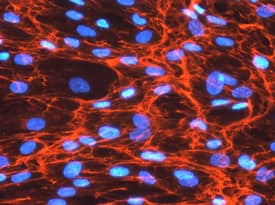Human Fibronectin Antibody
R&D Systems, part of Bio-Techne | Catalog # MAB19181

Key Product Details
Species Reactivity
Validated:
Human
Cited:
Human
Applications
Validated:
Immunocytochemistry
Cited:
Immunocytochemistry
Label
Unconjugated
Antibody Source
Monoclonal Mouse IgM Clone # P1F11
Product Specifications
Immunogen
Human plasma-derived Fibronectin
Specificity
Detects human Fibronectin.
Clonality
Monoclonal
Host
Mouse
Isotype
IgM
Scientific Data Images for Human Fibronectin Antibody
Fibronectin in WS-1 Human Cell Line.
Fibronectin was detected in immersion fixed WS-1 human fetal skin fibroblast cell line using 10 µg/mL Mouse Anti-Human Fibronectin Monoclonal Antibody (Catalog # MAB19181) for 3 hours at room temperature. Cells were stained with the NorthernLights™ 557-conjugated Anti-Mouse IgG Secondary Antibody (red; Catalog # NL007) and counter-stained with DAPI (blue). View our protocol for Fluorescent ICC Staining of Cells on Coverslips.Applications for Human Fibronectin Antibody
Application
Recommended Usage
Immunocytochemistry
8-25 µg/mL
Sample: Immersion fixed WS-1 human fetal skin fibroblast cell line
Sample: Immersion fixed WS-1 human fetal skin fibroblast cell line
Reviewed Applications
Read 1 review rated 5 using MAB19181 in the following applications:
Formulation, Preparation, and Storage
Purification
IgM-specific Affinity-purified from hybridoma culture supernatant
Reconstitution
Reconstitute at 0.5 mg/mL in sterile PBS. For liquid material, refer to CoA for concentration.
Formulation
Lyophilized from a 0.2 μm filtered solution in PBS with Trehalose. *Small pack size (SP) is supplied either lyophilized or as a 0.2 µm filtered solution in PBS.
Shipping
Lyophilized product is shipped at ambient temperature. Liquid small pack size (-SP) is shipped with polar packs. Upon receipt, store immediately at the temperature recommended below.
Stability & Storage
Use a manual defrost freezer and avoid repeated freeze-thaw cycles.
- 12 months from date of receipt, -20 to -70 °C as supplied.
- 1 month, 2 to 8 °C under sterile conditions after reconstitution.
- 6 months, -20 to -70 °C under sterile conditions after reconstitution.
Background: Fibronectin
References
- Mao, Y. and J.E. Schwarzbauer (2005) Matrix Biol. 24:389.
- Potts, J.R. and I.D. Campbell (1996) Matrix Biol. 15:313.
- Bernard, M.P. et al. (1985) Biochemistry 24:2698.
- Kornblihtt, A.R. et al. (1983) Proc. Natl. Acad. Sci. USA 80:3218.
- Kornblihtt, A.R. et al. (1985) EMBO J. 4:1755.
- Mould, A.P. et al. (1991) J. Biol. Chem. 266:3579.
- Abe, Y. et al. (2005) Biochem. Biophys. Res. Commun. 338:1640.
- Altroff, H. et al. (2004) J. Biol. Chem. 279:55995.
Alternate Names
CIG, ED-B, FINC, FN1, FNZ, GFND2, LETS, SMDCF
Gene Symbol
FN1
Additional Fibronectin Products
Product Documents for Human Fibronectin Antibody
Product Specific Notices for Human Fibronectin Antibody
For research use only
